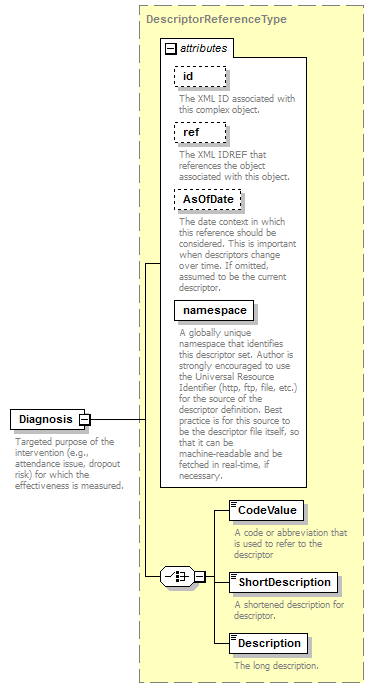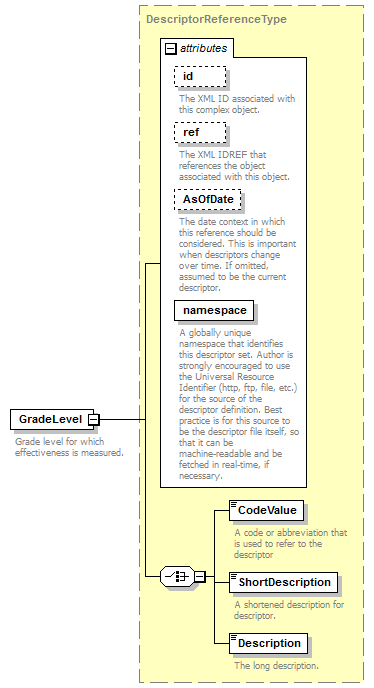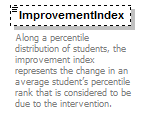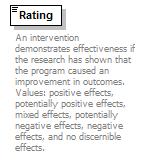complexType
InterventionEffectiveness
element InterventionEffectiveness/Diagnosis
element InterventionEffectiveness/PopulationServed
element InterventionEffectiveness/GradeLevel
element InterventionEffectiveness/ImprovementIndex
element InterventionEffectiveness/Rating
| diagram |  |
||||
| namespace | http://ed-fi.org/0110 | ||||
| children | Diagnosis PopulationServed GradeLevel ImprovementIndex Rating | ||||
| used by |
|
||||
| annotation |
|
||||
| source | <xs:complexType name="InterventionEffectiveness"> <xs:annotation> <xs:documentation>Measurement of the effectiveness of the intervention per diagnosis.</xs:documentation> <xs:appinfo> <ann:TypeGroup>Common</ann:TypeGroup> </xs:appinfo> </xs:annotation> <xs:sequence> <xs:element name="Diagnosis" type="DescriptorReferenceType"> <xs:annotation> <xs:documentation>Targeted purpose of the intervention (e.g., attendance issue, dropout risk) for which the effectiveness is measured.</xs:documentation> <xs:appinfo> <ann:Descriptor>DiagnosisDescriptor</ann:Descriptor> </xs:appinfo> </xs:annotation> </xs:element> <xs:element name="PopulationServed" type="PopulationServedType"> <xs:annotation> <xs:documentation>Population for which effectiveness is measured.</xs:documentation> </xs:annotation> </xs:element> <xs:element name="GradeLevel" type="DescriptorReferenceType"> <xs:annotation> <xs:documentation>Grade level for which effectiveness is measured.</xs:documentation> <xs:appinfo> <ann:Descriptor>GradeLevelDescriptor</ann:Descriptor> </xs:appinfo> </xs:annotation> </xs:element> <xs:element name="ImprovementIndex" type="xs:int" minOccurs="0"> <xs:annotation> <xs:documentation>Along a percentile distribution of students, the improvement index represents the change in an average student’s percentile rank that is considered to be due to the intervention.</xs:documentation> </xs:annotation> </xs:element> <xs:element name="Rating" type="InterventionEffectivenessRatingType"> <xs:annotation> <xs:documentation>An intervention demonstrates effectiveness if the research has shown that the program caused an improvement in outcomes. Values: positive effects, potentially positive effects, mixed effects, potentially negative effects, negative effects, and no discernible effects.</xs:documentation> </xs:annotation> </xs:element> </xs:sequence> </xs:complexType> |
element InterventionEffectiveness/Diagnosis
| diagram |  |
||||||||||||||||||||||||||||||||||||||
| namespace | http://ed-fi.org/0110 | ||||||||||||||||||||||||||||||||||||||
| type | DescriptorReferenceType | ||||||||||||||||||||||||||||||||||||||
| properties |
|
||||||||||||||||||||||||||||||||||||||
| children | CodeValue ShortDescription Description | ||||||||||||||||||||||||||||||||||||||
| attributes |
|
||||||||||||||||||||||||||||||||||||||
| annotation |
|
||||||||||||||||||||||||||||||||||||||
| source | <xs:element name="Diagnosis" type="DescriptorReferenceType"> <xs:annotation> <xs:documentation>Targeted purpose of the intervention (e.g., attendance issue, dropout risk) for which the effectiveness is measured.</xs:documentation> <xs:appinfo> <ann:Descriptor>DiagnosisDescriptor</ann:Descriptor> </xs:appinfo> </xs:annotation> </xs:element> |
element InterventionEffectiveness/PopulationServed
| diagram |  |
|||||||||||||||||||||||||||||||||
| namespace | http://ed-fi.org/0110 | |||||||||||||||||||||||||||||||||
| type | PopulationServedType | |||||||||||||||||||||||||||||||||
| properties |
|
|||||||||||||||||||||||||||||||||
| facets |
|
|||||||||||||||||||||||||||||||||
| annotation |
|
|||||||||||||||||||||||||||||||||
| source | <xs:element name="PopulationServed" type="PopulationServedType"> <xs:annotation> <xs:documentation>Population for which effectiveness is measured.</xs:documentation> </xs:annotation> </xs:element> |
element InterventionEffectiveness/GradeLevel
| diagram |  |
||||||||||||||||||||||||||||||||||||||
| namespace | http://ed-fi.org/0110 | ||||||||||||||||||||||||||||||||||||||
| type | DescriptorReferenceType | ||||||||||||||||||||||||||||||||||||||
| properties |
|
||||||||||||||||||||||||||||||||||||||
| children | CodeValue ShortDescription Description | ||||||||||||||||||||||||||||||||||||||
| attributes |
|
||||||||||||||||||||||||||||||||||||||
| annotation |
|
||||||||||||||||||||||||||||||||||||||
| source | <xs:element name="GradeLevel" type="DescriptorReferenceType"> <xs:annotation> <xs:documentation>Grade level for which effectiveness is measured.</xs:documentation> <xs:appinfo> <ann:Descriptor>GradeLevelDescriptor</ann:Descriptor> </xs:appinfo> </xs:annotation> </xs:element> |
element InterventionEffectiveness/ImprovementIndex
| diagram |  |
||||||||
| namespace | http://ed-fi.org/0110 | ||||||||
| type | xs:int | ||||||||
| properties |
|
||||||||
| annotation |
|
||||||||
| source | <xs:element name="ImprovementIndex" type="xs:int" minOccurs="0"> <xs:annotation> <xs:documentation>Along a percentile distribution of students, the improvement index represents the change in an average student’s percentile rank that is considered to be due to the intervention.</xs:documentation> </xs:annotation> </xs:element> |
element InterventionEffectiveness/Rating
| diagram |  |
|||||||||||||||||||||
| namespace | http://ed-fi.org/0110 | |||||||||||||||||||||
| type | InterventionEffectivenessRatingType | |||||||||||||||||||||
| properties |
|
|||||||||||||||||||||
| facets |
|
|||||||||||||||||||||
| annotation |
|
|||||||||||||||||||||
| source | <xs:element name="Rating" type="InterventionEffectivenessRatingType"> <xs:annotation> <xs:documentation>An intervention demonstrates effectiveness if the research has shown that the program caused an improvement in outcomes. Values: positive effects, potentially positive effects, mixed effects, potentially negative effects, negative effects, and no discernible effects.</xs:documentation> </xs:annotation> </xs:element> |
